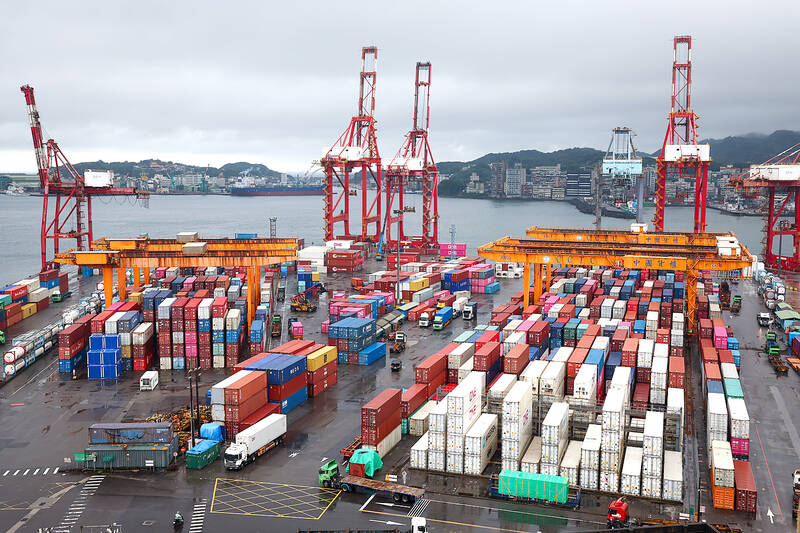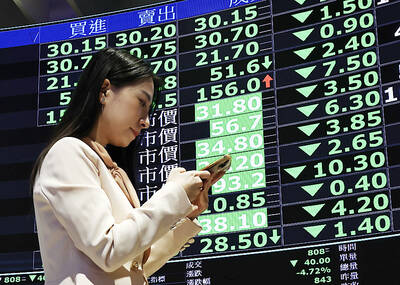Exports last month spiked 18.6 percent from a year earlier to a new high of US$49.57 billion, driven by front-loading demand on the part of corporations to cope with US President Donald Trump’s threat of “reciprocal” tariffs, the Ministry of Finance said yesterday.
Last month’s results turned out way better than expected, approaching the US$50 billion mark for the first time despite the weak seasonality, but it remains to be seen if the momentum is sustainable this month and beyond, Department of Statistics Director-General Beatrice Tsai (蔡美娜) said.
Tsai said she is looking at a flat showing for this month, when exports are likely to hold steady or grow 5 percent from the year-ago figures.

Photo: CNA
“The speculation doesn’t factor in US tariff hikes, because it is hard to predict Trump’s next moves and it is too early to gauge repercussions from Washington’s drastic tariffs on China,” Tsai said.
China, including Hong Kong, remains Taiwan’s largest export destination with a 28.9 percent share, though the US is catching up with a 25.7 percent share, propelled by the artificial intelligence (AI) craze, the ministry’s latest data showed.
Furthermore, it is not clear how Taiwanese firms would tackle the major shift in US trade policy, Tsai said.
Some would wait and see, while others are adjusting their global footprint, the official said.
Still others might be pushed out of the market altogether due to a lack of competitiveness, she added.
Regardless, Taiwan’s exports in the first quarter swelled 17.5 percent year-on-year to US$129.58 billion, beating the forecast of the Directorate-General of Budget, Accounting and Statistics (DGBAS) by 7.3 percentage points, Tsai said.
That is favorable for GDP growth, but economic policymakers and academics have voiced grave concern that Taiwan’s export-focused economy would start to feel the pain of tariffs in the second half.
Shipments of semiconductors expanded 20.6 percent to US$16.46 billion, while information and communications technology products grew 34 percent to US$16.94 billion, Tsai said, adding that the fast growth also had much to do with AI development.
Front-loading activity extended to non-tech products, as seen in double-digit increases in shipments of electrical, optical and mineral products, the ministry said.
Textile and plastic products bucked the upward trend with declines of 6.8 percent and 4.6 percent respectively, as a supply glut and rising competition from Chinese rivals continued to weigh, Tsai said.
At the same time, imports rose 28.8 percent annually to US$42.6 billion, leaving a trade surplus of US$6.95 billion, a 20.1 percent retreat from a year earlier, the official said.
In the first three months, imports amounted to US$106.02 billion, also stronger than the DGBAS’ projection.
Taiwan’s policymakers have suggested the country buy more military weapons, energy and agricultural products from the US to mitigate trade surpluses with the US and appease Trump.

TARIFFS: The global ‘panic atmosphere remains strong,’ and foreign investors have continued to sell their holdings since the start of the year, the Ministry of Finance said The government yesterday authorized the activation of its NT$500 billion (US$15.15 billion) National Stabilization Fund (NSF) to prop up the local stock market after two days of sharp falls in reaction to US President Donald Trump’s new import tariffs. The Ministry of Finance said in a statement after the market close that the steering committee of the fund had been given the go-ahead to intervene in the market to bolster Taiwanese shares in a time of crisis. The fund has been authorized to use its assets “to carry out market stabilization tasks as appropriate to maintain the stability of Taiwan’s

STEEP DECLINE: Yesterday’s drop was the third-steepest in its history, the steepest being Monday’s drop in the wake of the tariff announcement on Wednesday last week Taiwanese stocks continued their heavy sell-off yesterday, as concerns over US tariffs and unwinding of leveraged bets weighed on the market. The benchmark TAIEX plunged 1,068.19 points, or 5.79 percent, to 17,391.76, notching the biggest drop among Asian peers as it hit a 15-month low. The decline came even after the government on late Tuesday authorized the NT$500 billion (US$15.2 billion) National Stabilization Fund (國安基金) to step in to buoy the market amid investors’ worries over tariffs imposed by US President Donald Trump. Yesterday’s decline was the third-steepest in its history, trailing only the declines of 2,065.87 points on Monday and

TAKING STOCK: A Taiwanese cookware firm in Vietnam urged customers to assess inventory or place orders early so shipments can reach the US while tariffs are paused Taiwanese businesses in Vietnam are exploring alternatives after the White House imposed a 46 percent import duty on Vietnamese goods, following US President Donald Trump’s announcement of “reciprocal” tariffs on the US’ trading partners. Lo Shih-liang (羅世良), chairman of Brico Industry Co (裕茂工業), a Taiwanese company that manufactures cast iron cookware and stove components in Vietnam, said that more than 40 percent of his business was tied to the US market, describing the constant US policy shifts as an emotional roller coaster. “I work during the day and stay up all night watching the news. I’ve been following US news until 3am

TARIFF CONCERNS: The chipmaker cited global uncertainty from US tariffs and a weakening economic outlook, but said its Singapore expansion remains on track Vanguard International Semiconductor Corp (世界先進), a foundry service provider specializing in producing power management and display driver chips, yesterday withdrew its full-year revenue projection of moderate growth for this year, as escalating US tariff tensions raised uncertainty and concern about a potential economic recession. The Hsinchu-based chipmaker in February said revenues this year would grow mildly from last year based on improving supply chain inventory levels and market demand. At the time, it also anticipated gradual quarter revenue growth. However, the US’ sweeping tariff policy has upended the industry’s supply chains and weakened economic prospects for the world economy, it said. “Now